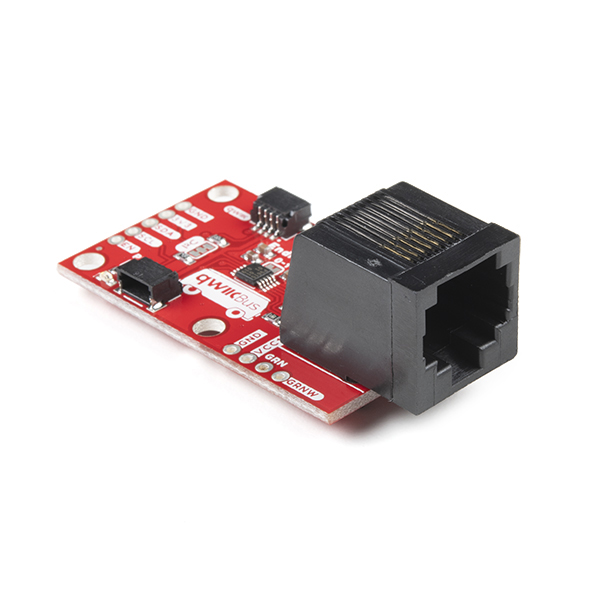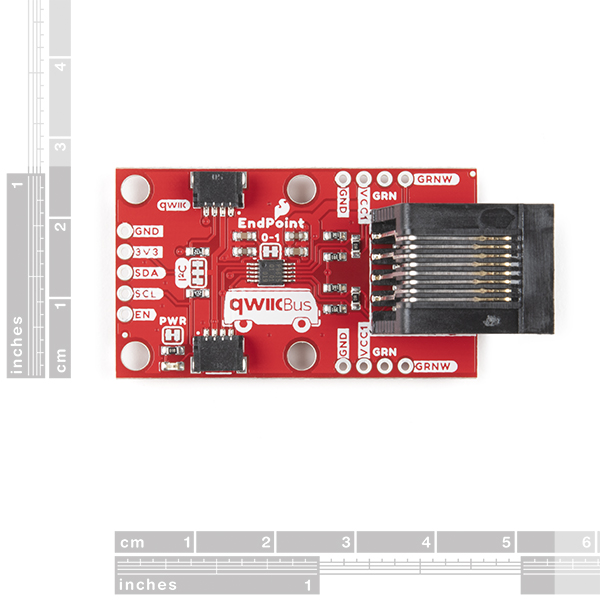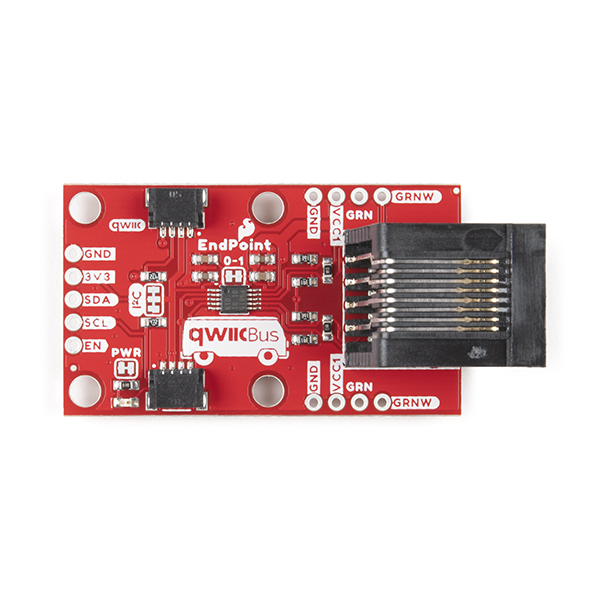SparkFun QwiicBus - EndPoint
The SparkFun QwiicBus EndPoint is the fastest and easiest way to extend the range of your I2C communication bus. The breakout uses NXP’s PCA9615 IC, which converts the two default I2C signals into four differential signals, two for SCL and two for SDA. The differential signals are sent over an Ethernet cable, which attaches to the breakout through the on-board RJ-45 connectors. The differential signaling allows the I2C signals to reach distances of up to 100ft. while still maintaining their signal integrity! To make it even easier to get your readings, all communication is enacted exclusively via I2C, utilizing our handy Qwiic system so no soldering is required to connect it to the rest of your system. However, we still have broken out 0.1"-spaced pins in case you prefer to use a breadboard.
The simplicity of the QwiicBus EndPoint is one of its biggest appeals. Other I2C communication methods require packetizing I2C communication into another protocol, be it RS-485 or 1-Wire. However, the PCA9615 keeps the I2C protocol by utilizing a differential transceiver.
This updated version of the Differential I2C Breakout adds two 0.1" spaced pins connected to the unused pair of wires on the RJ-45 connectors so users can easily take advantage of the unused pair for whatever they would like.
Whether you need to extend the range of an I2C sensor on an autonomous vehicle plagued with noise from motors or want to create a vast sensor network in your home or office, the QwiicBus EndPoint is a great solution to extend distance and reduce noise susceptibility.
The SparkFun Qwiic Connect System is an ecosystem of I2C sensors, actuators, shields and cables that make prototyping faster and less prone to error. All Qwiic-enabled boards use a common 1mm pitch, 4-pin JST connector. This reduces the amount of required PCB space, and polarized connections mean you can’t hook it up wrong.
- Uses the PCA9615 buffer IC
- I2C Supply voltage range: 2.3-5.5V
- Differential Supply voltage range: 3-5.5V
- Multiple power configurations depending on application needs
- Extends I2C bus up to 100 feet
- 2x Qwiic Connectors
SparkFun QwiicBus - EndPoint Product Help and Resources
SparkFun QwiicBus Hookup Guide
April 1, 2021
Build a long-range, noise-isolated I2C bus with the SparkFun QwiicBus Kit featuring the QwiicBus EndPoint and MidPoint following this Hookup Guide.
Comments
Looking for answers to technical questions?
We welcome your comments and suggestions below. However, if you are looking for solutions to technical questions please see our Technical Assistance page.
Customer Reviews
4 out of 5
Based on 4 ratings:
2 of 2 found this helpful:
Hot diggity dang! I love this.
So great. So simple. Plug. Play. Send an I2C signal over multmultiple yards/meters.
Not well documented, and not well supported
I connected 2 of these EndPoints together and it did not work. I read thru the documentation and found nothing. As SparkFun instructs in such cases, I posted a tech-support question on the forums (https://forum.sparkfun.com/viewtopic.php?f=105&t=57696&p=233244), and only got back a partial cryptic reply. My follow-up post trying to get specific details was ignored.
Worked great out of the box.
Am using a grove mkr shield with a different I2c plug style, nevertheless, soldered the leads into the header of these boards, attached to grove I2c plug, attached 25m of Ethernet cable, attached terminal end of this board to I2c hub and temp sensor and it worked instantly. No fuss. Was nervous that this would be over my head, but it was so great I took time to write this.
K3NG Rotator Controller Project
I'm currently working on the HAM radio project "K3NG Rotator Controller" for Satellite radio communications with the Radio Artisan/ Groups IO and without the QwiicBus there is no accurate reading of the Azimuth and Elevation sensor of my Antenna Rotator Controller. QwiicBus solved the I2C connection problem with LSM303DLHC sensor board.





Hey Sparkfun! It's ex-employee Cody!
This works great! I designed our laser system off of the qwiic i2c architecture. I was able to successfully test these endpoints with a 100ft ethernet cable.
-I have a mainboard with a usb/i2c converter which controls the qwiic bus. Also on the mainboard is a qwiic multiplexer, and 8 of these qwiic endpoints. -Then ethernet cables spiderweb out to other boards I designed which house TIC steppers from Pololu, and qwiic connectors. -I used the green pair on the RJ45 to send out the motor power as well as all of the qwiic i2c logic. -Each multiplexer channel controls up to 5 stepper motors, and an array of qwiic sensors.
I hope you guys are Sparkfun are all doing well! I miss y'all
I tell you what, put 8 of these in a box along with a BOB-16784 and you would sell a lot of them.